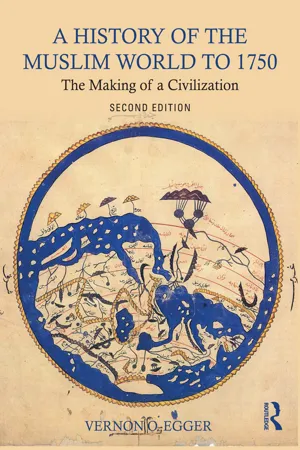
- 568 pages
- English
- ePUB (mobile friendly)
- Available on iOS & Android
About this book
A History of the Muslim World to 1750 traces the development of Islamic civilization from the career of the Prophet Muhammad to the mid-eighteenth century. Encompassing a wide range of significant events within the period, its coverage includes the creation of the Dar al-Islam (the territory ruled by Muslims), the fragmentation of society into various religious and political groups including the Shi'ites and Sunnis, the series of catastrophes in the twelfth and thirteenth centuries that threatened to destroy the civilization, and the rise of the Ottoman, Safavid, and Mughal empires.
Including the latest research from the last ten years, this second edition has been updated and expanded to cover the fifteenth to eighteenth centuries. Fully refreshed and containing over sixty images to highlight the key visual aspects, this book offers students a balanced coverage of the Muslim world from the Iberian Peninsula to South Asia, and detailed accounts of all cultures. The use of maps, primary sources, timelines, and a glossary further illuminates the fascinating yet complex world of the pre-modern Middle East.
Covering art, architecture, religious institutions, theological beliefs, popular religious practice, political institutions, cuisine, and much more, A History of the Muslim World to 1750 is the perfect introduction for all students of the history of Islamic civilization and the Middle East.
Frequently asked questions
- Essential is ideal for learners and professionals who enjoy exploring a wide range of subjects. Access the Essential Library with 800,000+ trusted titles and best-sellers across business, personal growth, and the humanities. Includes unlimited reading time and Standard Read Aloud voice.
- Complete: Perfect for advanced learners and researchers needing full, unrestricted access. Unlock 1.4M+ books across hundreds of subjects, including academic and specialized titles. The Complete Plan also includes advanced features like Premium Read Aloud and Research Assistant.
Please note we cannot support devices running on iOS 13 and Android 7 or earlier. Learn more about using the app.
Information
Part One
The Formative Period, 610–950
| 570 | Traditional date for the birth of Muhammad |
| 602–628 | Last Byzantine–Sasanian war |
| 610 | Traditional date for the first revelation to Muhammad |
| 622 | Hijra |
| 632 | Death of Muhammad; Abu Bakr becomes caliph |
| 633 | Muslim army crushes Ridda |
| 634 | Muslim conquests begin; ‘Umar becomes caliph |
| 637 | Muslim armies conquer Syria |
| 638 | Muslim armies conquer Iraq |
| 642 | Muslim armies conquer Egypt |
| 644 | Slave murders ‘Umar; ‘Uthman becomes caliph |
| 651 | Muslim armies conquer Iran |
| 656 | Muslim soldiers murder ‘Uthman; ‘Ali becomes caliph |
| 661 | Kharijite murders ‘Ali; Mu‘awiya becomes caliph in Damascus; Umayyad dynasty begins |
| 680 | Battle of Karbala |
| 685–705 | Caliphate of ‘Abd al-Malik, who makes Arabic the official language of the empire, mints coins with Islamic details and builds Dome of the Rock as symbol of Islamic supremacy |
| 705–715 | Muslim armies conquer Central Asia and Sind |
| 711–720 | Muslim armies conquer Iberian peninsula |
| 740 | Berber revolt in North Africa and Iberia |
| 750 | Abbasids overthrow Umayyads |
| 756 | ‘Abd al-Rahman establishes the Umayyad amirate of Cordoba |
| 762 | Al-Mansur founds Baghdad |
| 765 | Death of Ja‘far al-Sadiq |
| 768–814 | Reign of Charlemagne in Western Europe |
| 813–833 | Caliphate of al-Ma’mun creates the Bayt al-Hikma and provokes a storm of criticism for his attempt to enforce Mu‘tazilism |
| 860s | Anarchy in Baghdad, provinces become autonomous; Isma‘ilis become active in Iran, Iraq, and Syria |
| 874 | Imami twelfth Imam goes into Lesser Concealment |
| 850–900 | Feudalism emerges in Western Europe |
| 909 | Fatimids declare a caliphate in Ifriqiya |
| 900–950 | Acceptance of Shafi‘i synthesis for jurisprudence |
| 929 | ‘Abd al-Rahman III declares a caliphate in Cordoba |
| 936 | Abbasid caliph cedes power to Turkish general |
| 941 | Imami twelfth Imam goes into Greater Concealment |
| 945 | Buyids seize power in Baghdad |
Chapter 1
Origins
Southwest Asia in the Seventh Century
The Byzantine Empire

Table of contents
- Cover
- Title
- Copyright
- Contents
- List of Figures
- List of Maps
- List of Tables
- Preface to the Second Edition
- Preface to the First Edition
- Acknowledgements
- Note on Transliteration and Dating
- PART ONE THE FORMATIVE PERIOD, 610–950
- PART TWO CIVILIZATION VS. CHAOS, 950–1260
- PART THREE MONGOL HEGEMONY, 1260–1405
- PART FOUR MUSLIM ASCENDANCY, 1405–1750
- Glossary
- Index